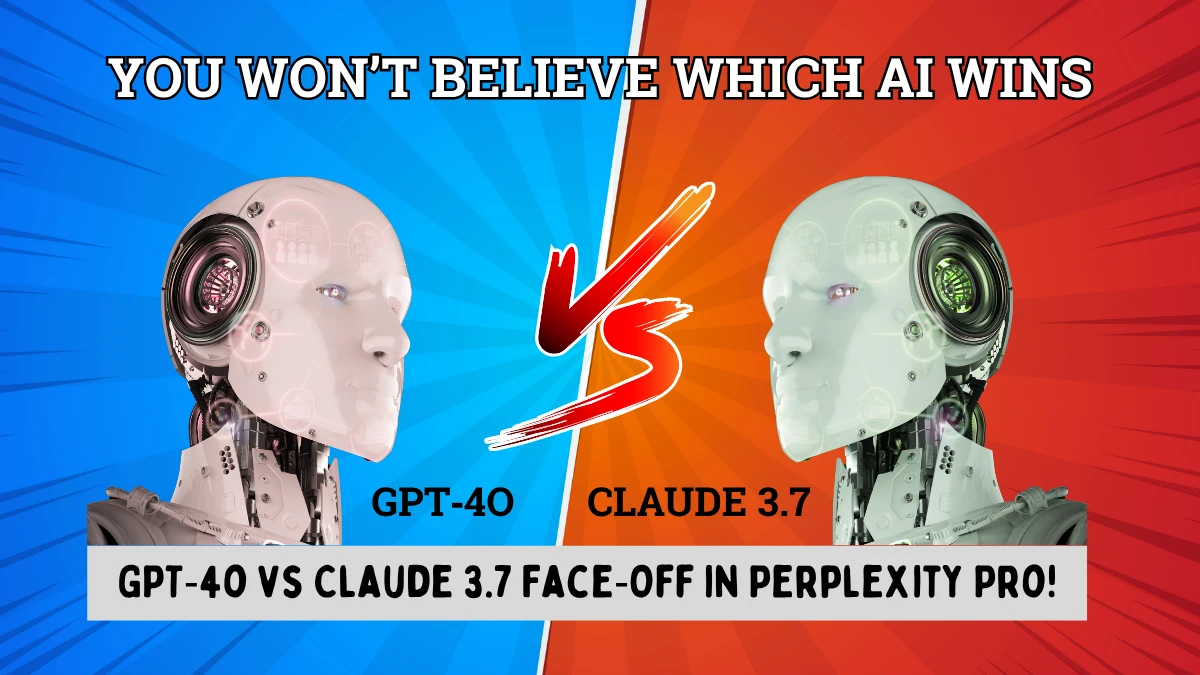Table of Contents
GPT-4o Vs Claude 3.7 in Perplexity Pro: The artificial intelligence landscape has evolved dramatically, with two models standing at the forefront of innovation: GPT-4o and Claude 3.7. For AI professionals, students, and IT companies seeking to optimize their workflows through Perplexity Pro, understanding the nuances between these powerful models is essential. This comprehensive comparison will guide you through the capabilities, strengths, and practical applications of both models, helping you make an informed decision for your specific needs.

Understanding the Core Architecture and Capabilities
GPT-4o: The Multimodal Powerhouse
GPT-4o represents OpenAI’s latest advancement in artificial intelligence, building upon the success of its predecessors while introducing significant improvements in processing speed and multimodal capabilities. This model excels in handling text, images, and audio inputs simultaneously, making it particularly valuable for complex AI workflows that require diverse data processing.
The architecture of GPT-4o demonstrates enhanced reasoning capabilities, with improved performance in mathematical calculations, code generation, and creative writing tasks. For IT professionals working on diverse projects, GPT-4o offers consistent performance across multiple domains, from technical documentation to complex problem-solving scenarios. GPT-4o Vs Claude 3.7 in Perplexity Pro.
One of the standout features of GPT-4o is its ability to maintain context across longer conversations while providing more accurate responses. This capability proves invaluable for students conducting research or professionals engaged in extended analytical sessions through Perplexity Pro.
Claude 3.7: The Reasoning Specialist
Claude 3.7, developed by Anthropic, represents a significant leap forward in AI reasoning and safety. This model has been specifically designed to excel in analytical thinking, ethical reasoning, and nuanced understanding of complex topics. For AI experts and IT companies prioritizing accuracy and reliability, Claude 3.7 offers exceptional performance in critical thinking tasks.
The model’s training emphasizes constitutional AI principles, resulting in more thoughtful and well-reasoned responses. This approach makes Claude 3.7 particularly suitable for academic research, professional analysis, and scenarios where accuracy takes precedence over speed. GPT-4o Vs Claude 3.7 in Perplexity Pro.
Claude 3.7 demonstrates superior performance in tasks requiring careful analysis, fact-checking, and structured reasoning. Students and researchers working on complex projects will find this model’s methodical approach to problem-solving particularly beneficial.

Performance Comparison in Real-World Scenarios
Code Generation and Technical Documentation
When comparing GPT-4o vs Claude in coding tasks, both models show impressive capabilities, but with distinct strengths. GPT-4o tends to generate code more quickly and handles a broader range of programming languages with consistent quality. The model excels in creating functional prototypes and providing multiple solution approaches for complex programming challenges. GPT-4o Vs Claude 3.7 in Perplexity Pro.
Claude 3.7, while potentially slower in initial code generation, often produces more thoroughly documented and maintainable code. The model’s approach to programming emphasizes best practices, security considerations, and comprehensive error handling. For IT companies focusing on enterprise-level development, Claude 3.7’s methodical approach often results in more robust solutions.
Research and Analysis Tasks
In research-intensive workflows, the choice between these models becomes crucial. GPT-4o demonstrates excellent performance in gathering and synthesizing information from multiple sources quickly. The model’s ability to process various input types makes it ideal for multimedia research projects and rapid prototyping of ideas. GPT-4o Vs Claude 3.7 in Perplexity Pro.
Claude 3.7 excels in deep analytical tasks, providing more thorough examination of complex topics and offering nuanced perspectives on multifaceted issues. For academic researchers and AI experts conducting detailed studies, Claude 3.7’s methodical approach often yields more comprehensive and academically rigorous results.
Creative and Content Generation
Both models offer impressive creative capabilities, but their approaches differ significantly. GPT-4o tends to be more versatile in creative tasks, generating content across various formats and styles with remarkable consistency. The model’s ability to adapt its writing style to different audiences makes it particularly valuable for diverse content creation needs. GPT-4o Vs Claude 3.7 in Perplexity Pro.
Claude 3.7 approaches creative tasks with more structured thinking, often producing content that demonstrates deeper consideration of context and audience. While it may take longer to generate initial drafts, the resulting content often requires less revision and editing.

Navigating Perplexity Pro: Model Selection Strategy
Understanding Perplexity Pro’s Integration
Perplexity Pro offers seamless integration with both GPT-4o and Claude 3.7, allowing users to leverage the strengths of each model based on specific task requirements. The platform’s interface provides clear options for model selection, enabling users to switch between models based on their current needs. GPT-4o Vs Claude 3.7 in Perplexity Pro.
The integration allows for comparative analysis, where users can submit identical queries to both models and evaluate the responses. This feature proves particularly valuable for IT professionals and AI experts who need to validate results across different AI systems.
Optimizing Workflow with Model Switching
Effective use of Perplexity Pro involves understanding when to utilize each model’s strengths. For rapid brainstorming and initial concept development, GPT-4o’s speed and versatility make it an excellent choice. When transitioning to detailed analysis and refinement phases, Claude 3.7’s thorough approach becomes more valuable. GPT-4o Vs Claude 3.7 in Perplexity Pro.
Students working on research projects can benefit from using GPT-4o for initial research and idea generation, then switching to Claude 3.7 for critical analysis and synthesis of findings. This approach combines the efficiency of GPT-4o with the analytical depth of Claude 3.7.

Practical Applications for Different User Groups
For AI Experts and Researchers
AI professionals require models that can handle complex theoretical discussions and provide insights into cutting-edge developments. GPT-4o’s broad knowledge base and ability to process diverse inputs make it excellent for exploring emerging trends and technologies. The model’s capability to generate hypotheses and suggest research directions proves invaluable for ongoing projects. GPT-4o Vs Claude 3.7 in Perplexity Pro.
Claude 3.7’s strength lies in providing detailed analysis of existing research and identifying potential limitations or biases in current approaches. For peer review processes and academic writing, Claude 3.7’s methodical evaluation of evidence and logical reasoning capabilities offer significant advantages.
For Students and Academic Users
Students benefit from different aspects of each model depending on their academic level and subject area. GPT-4o excels in providing quick explanations of complex concepts and generating study materials across various subjects. The model’s ability to adapt explanations to different comprehension levels makes it particularly valuable for diverse learning needs. GPT-4o Vs Claude 3.7 in Perplexity Pro.
Claude 3.7 proves more beneficial for advanced students working on thesis projects or detailed research papers. The model’s emphasis on critical thinking and thorough analysis helps develop academic writing skills and research methodologies.
For IT Companies and Professionals
IT companies must consider factors such as reliability, consistency, and integration capabilities when selecting AI models. GPT-4o’s versatility makes it suitable for diverse business applications, from customer support automation to content management systems. The model’s ability to handle multiple input types supports various business workflows. GPT-4o Vs Claude 3.7 in Perplexity Pro.
Claude 3.7’s focus on accuracy and ethical reasoning makes it particularly suitable for applications requiring high reliability, such as compliance monitoring, risk assessment, and strategic planning. Companies prioritizing data accuracy and regulatory compliance often find Claude 3.7’s approach more aligned with their requirements.

Cost-Benefit Analysis and Resource Optimization
Understanding Usage Patterns
Effective model selection requires understanding usage patterns and associated costs. GPT-4o’s efficiency in handling routine tasks can result in lower per-query costs for high-volume applications. The model’s speed advantages translate to improved productivity for time-sensitive projects. GPT-4o Vs Claude 3.7 in Perplexity Pro.
Claude 3.7’s thorough approach may result in higher per-query costs but often reduces the need for follow-up queries and revisions. For critical applications where accuracy is paramount, the initial investment in Claude 3.7 often proves more cost-effective in the long term.
Optimizing Resource Allocation
Organizations can optimize their AI tool usage by developing clear guidelines for model selection based on task requirements. Routine tasks, quick research, and initial drafts can be handled efficiently by GPT-4o, while critical analysis, final reviews, and high-stakes decisions benefit from Claude 3.7’s thorough approach.

Future Considerations and Emerging Trends
Model Evolution and Updates
Both GPT-4o and Claude 3.7 continue to evolve, with regular updates improving performance and capabilities. Staying informed about these developments is crucial for maintaining optimal AI workflows. GPT-4o’s development focuses on expanding multimodal capabilities and improving integration with various platforms. GPT-4o Vs Claude 3.7 in Perplexity Pro.
Claude 3.7’s evolution emphasizes enhanced reasoning capabilities and improved safety measures. Understanding these development trajectories helps organizations plan their long-term AI strategies effectively.
Integration with Emerging Technologies
The future of AI model selection will likely involve more sophisticated integration with specialized tools and platforms. Both models show promise for integration with emerging technologies such as advanced data visualization tools, collaborative platforms, and specialized domain applications.

Making Your Decision: A Strategic Framework
Choosing between GPT-4o and Claude 3.7 in Perplexity Pro requires careful consideration of your specific needs, resources, and objectives. For users requiring versatility, speed, and broad capability across multiple domains, GPT-4o offers compelling advantages. Its ability to handle diverse inputs and provide rapid responses makes it ideal for dynamic, fast-paced environments.
For users prioritizing accuracy, detailed analysis, and methodical reasoning, Claude 3.7 represents the superior choice. Its emphasis on thorough analysis and ethical reasoning makes it particularly suitable for academic research, professional analysis, and critical decision-making processes.
The optimal approach for many users involves leveraging both models strategically, using GPT-4o for initial exploration and rapid development, then employing Claude 3.7 for detailed analysis and refinement. This combined approach maximizes the benefits of both models while minimizing their respective limitations. GPT-4o Vs Claude 3.7 in Perplexity Pro.
Understanding your specific requirements, evaluating the comparative strengths of each model, and developing a strategic approach to model selection will enable you to maximize the value of your Perplexity Pro investment. Whether you’re an AI expert pushing the boundaries of research, a student exploring complex academic topics, or an IT professional developing innovative solutions, the choice between GPT-4o and Claude 3.7 will significantly impact your success and productivity.

Frequently Asked Questions (FAQs) About GPT-4o Vs Claude 3.7 in Perplexity Pro
What are the core architectural differences between GPT-4o and Claude 3.7?
Answer: GPT‑4o is a multimodal model by OpenAI designed to ingest and process text, images, and audio in a single pass, with accelerated reasoning and creative capabilities. Claude 3.7, from Anthropic, focuses on deep analytical reasoning and safety, guided by constitutional AI principles to ensure ethically aligned, well‑reasoned responses. GPT-4o Vs Claude 3.7 in Perplexity Pro.
Which model excels at multimodal tasks like image‑and‑text analysis?
Answer: GPT‑4o shines in multimodal scenarios, seamlessly integrating text, image, and audio inputs. If your workflow involves parsing diagrams, screenshots, or mixed‑media content, GPT‑4o will generally deliver faster and more cohesive results. GPT-4o Vs Claude 3.7 in Perplexity Pro.
For rigorous academic research and fact‑checking, which model should I choose?
Answer: Claude 3.7 is optimized for academic rigor and ethical reasoning. Its training emphasizes methodical analysis, making it ideal for deep dives into complex subjects, structured literature reviews, and precision‑focused fact‑checking. GPT-4o Vs Claude 3.7 in Perplexity Pro.
How do GPT-4o and Claude 3.7 compare in code generation and documentation?
Answer: GPT‑4o produces code quickly across a wide range of languages and offers multiple solution approaches, perfect for rapid prototyping. Claude 3.7 generates code more methodically, with thorough comments, security considerations, and error‑handling best practices—suited for enterprise‑grade, maintainable codebases. GPT-4o Vs Claude 3.7 in Perplexity Pro.
Can I switch models mid‑session in Perplexity Pro?
Answer: Yes. Perplexity Pro lets you toggle between GPT‑4o and Claude 3.7 on the fly. You can submit the same query to both models, compare outputs side by side, and choose the best‑fit response for your current task. GPT-4o Vs Claude 3.7 in Perplexity Pro.

What’s the optimal strategy for integrating both models into my workflow?
Answer: Use GPT‑4o for brainstorming, initial drafts, and rapid information gathering. Transition to Claude 3.7 for deep analysis, final reviews, and tasks where accuracy and ethical reasoning are paramount. This hybrid approach leverages speed and depth effectively. GPT-4o Vs Claude 3.7 in Perplexity Pro.
How do their costs and resource usage compare?
Answer: GPT‑4o’s faster throughput often translates to lower per‑query costs for high‑volume or routine tasks. Claude 3.7 may incur higher costs per query due to its thoroughness, but it can reduce downstream revision needs—potentially saving resources in high‑stakes or compliance‑driven projects. GPT-4o Vs Claude 3.7 in Perplexity Pro.
Which model is better for creative content generation?
Answer: GPT‑4o offers greater versatility in style adaptation and format variety, making it strong for diverse creative writing, marketing copy, and multimedia storytelling. Claude 3.7 provides more structured, context‑aware content that often requires fewer edits but may take longer to generate. GPT-4o Vs Claude 3.7 in Perplexity Pro.
How do future updates factor into my decision?
Answer: Both models are evolving—GPT‑4o continues to expand its multimodal prowess and integration options, while Claude 3.7 focuses on enhanced safety, reasoning, and domain‑specific tuning. Stay informed of release notes to align your choice with the latest capabilities. GPT-4o Vs Claude 3.7 in Perplexity Pro.
Which use cases best suit each model?
Answer:
GPT‑4o: Rapid prototyping, multimedia research, customer‑facing automation, and creative drafting.
Claude 3.7: Academic research, compliance monitoring, risk assessment, strategic planning, and any scenario demanding meticulous reasoning and ethical alignment. GPT-4o Vs Claude 3.7 in Perplexity Pro.

3 thoughts on “Discover the Supreme Choice: GPT-4o Vs Claude 3.7 in Perplexity Pro!”